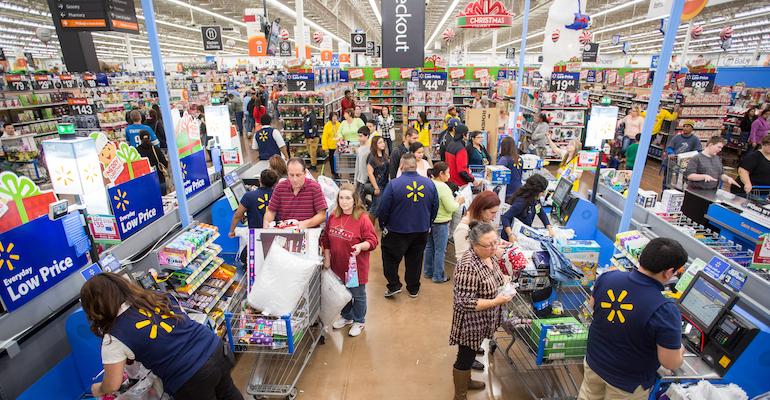Despite consumer and retailer concerns about pandemic-related supply issues, 2021 U.S. holiday retail sales are expected to vault over last year’s total, potentially growing by double digits.
The National Retail Federation (NRF) projects November/December retail sales of $843.4 billion to $859 billion, up 8.5% to 10.5% from 2020 results. NRF said its forecast — excluding automobile dealers, gas stations and restaurants and covering Nov. 1 to Dec. 31— tops the previous high of $777.3 billion, up 8.2%, in 2020 as well as the average gain of 4.4% over the past five years.
Likewise, business consultancy Deloitte forecasts significantly higher holiday sales for 2021, estimating growth of 7% to 9% to between $1.28 and $1.3 trillion during the November-to-January time span. That’s well over Deloitte’s 1% to 1.5% projection for 2020 and the U.S. Census Bureau’s November 2020-to-January 2021 sales growth measure of 5.8% to $1.19 trillion (seasonally adjusted, excluding autos and fuel).
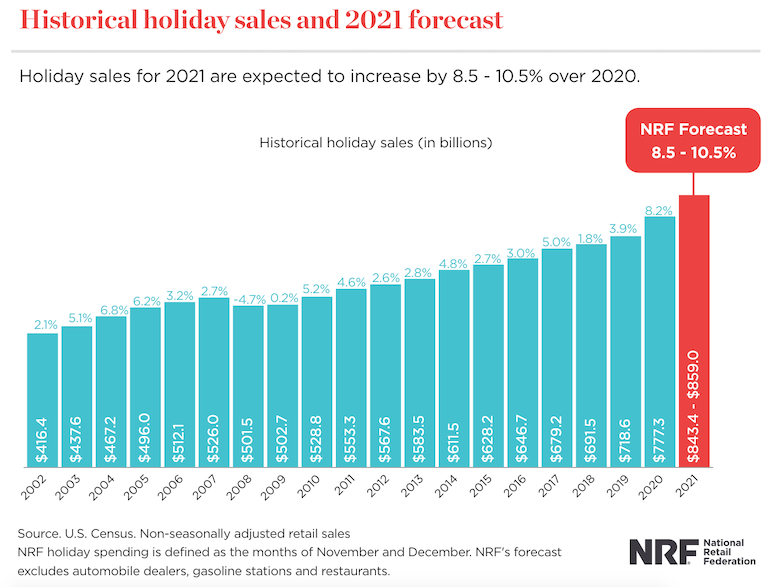
“There is considerable momentum heading into the holiday shopping season,” NRF President and CEO Matthew Shay said in a statement. “Consumers are in a very favorable position going into the last few months of the year, as income is rising and household balance sheets have never been stronger. Retailers are making significant investments in their supply chains and spending heavily to ensure they have products on their shelves to meet this time of exceptional consumer demand.”
Consumers plan to spend an average of $997.73 this year, just over the 2020 total of $997 yet below the pre-pandemic high of $1,047.83 in 2019, reported NRF, based on its annual holiday spending survey conducted by Prosper Insights & Analytics. The lion’s share of 2021 spending will go toward gifts at $648 (down $2 from 2020), followed by $231 for non-gift holiday items such as food, candy, decorations and cards (up $1 from 2020) and $118 for other non-gift purchases (up $1 from 2020).
“The outlook for the holiday season looks very bright,” according to NRF Chief Economist Jack Kleinhenz. “The unusual and beneficial position we find ourselves in is that households have increased spending vigorously throughout most of 2021 and remain with plenty of holiday purchasing power.”
New York-based Deloitte pegs 2021 holiday spending at an average of $1,463 per household (November-to-January), up 5% from $1,387 in 2020 but 7% less than the $1,496 estimate for 2019. Average household spending on gifts is forecast at $501 for this year, up 3% from $487 in 2020 yet 5% below $511 in 2019. Non-gift purchases are expected to dip 2% to $426 in 2021 from $435 last year but grow 12% on a two-year stack from $389 in 2019. Meanwhile, consumer expenditures for experiences — such as socializing, travel and entertaining — are expected to rebound, climbing 15% to $536 this year from $465 in 2020, which marked a 22% drop from $596 in 2019.
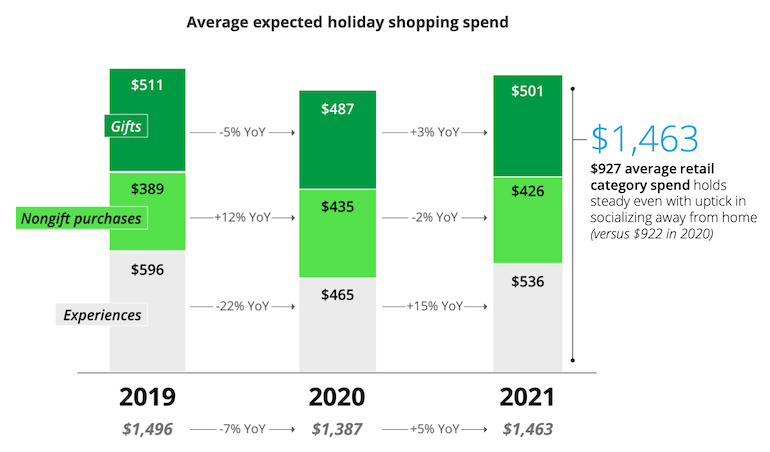
Retail executives appear optimistic this holiday season, with seven in 10 expecting shoppers to spend more year over year, according to the 2021 Deloitte Holiday Retail Survey.
“We anticipate strong consumer spending for the upcoming holiday season. As vaccination rates rise and consumers are more comfortable being outside of the home, we are likely to see increased spending on services, including restaurants and travel, while spending on goods will continue to hold steady. A steady decline in the savings rate to pre-pandemic levels will support consumer spending and keep retail sales elevated this season,” observed Daniel Bachman, U.S. economic forecaster at Deloitte. “Further, e-commerce sales will continue to grow as consumers demonstrate an ongoing and steady movement toward buying online across all categories.”
E-commerce to stay strong as in-store rebounds
As last year, U.S. online holiday retail sales stand to see robust growth. Deloitte projects e-commerce sales for November 2021 to January 2022 to climb 11% to 15% to between $210 billion and $218 billion — still rising by double digits but less than the 34.8% gain to $189 billion reported by the Census Bureau for 2020 (seasonally adjusted, excluding fuel, vehicle and parts dealers, and foodservice).
Online’s share of holiday spend is expected to remain high, at 62% for 2021 versus 64% in 2020, well above the 59% seen in 2019, Deloitte’s annual survey said. With COVID-19 vaccinations up and the incidence of coronavirus down, in-store spending for the holidays is forecast to rebound to a 33% share in 2021 from 28% in 2020, nearing the 36% mark estimated for 2019. This year, average household spend is pegged at $924 for online, more than double the $440 expected for in-store.
“Across channels, retailers should expect a strong holiday season, as consumer spending levels are projected to remain high,” explained Rod Sides, vice chairman at Deloitte and U.S. retail and distribution sector leader. “While consumer concerns about health and safety have eased since the last holiday season, pandemic-influenced shopping behaviors continue to gain traction. Retailers who remain resilient to shifting consumer behaviors and offer convenient options for online and in-store shopping, as well as order fulfillment, will be poised for growth this holiday season, and into the new year.”
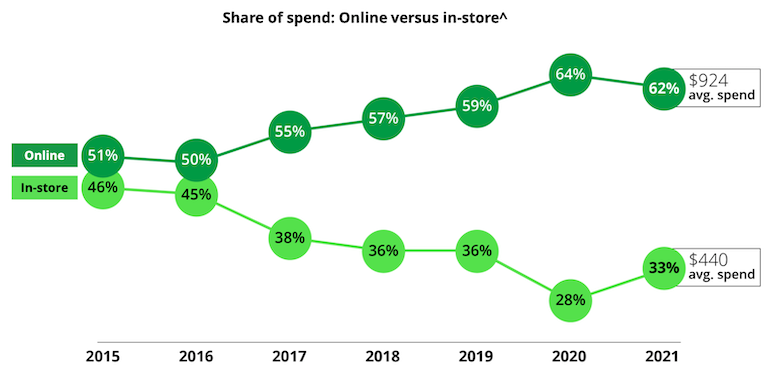
NRF also projects 11% to 15% holiday retail spending growth for online and other non-store sales in 2021, reaching $218.3 billion to $226.2 billion, compared with $196.7 billion in 2020, which saw a 23.9% gain.
“Last year saw extraordinary growth in digital channels as consumers turned to online shopping to meet their holiday needs during the pandemic,” NRF stated. “While e-commerce will remain important, households are also expected to shift back to in-store shopping and a more traditional holiday shopping experience.”
Of the more than 7,900 consumers polled earlier this month in the NRF/Prosper winter holidays spending survey, 57% said they plan to buy holiday items online this year, down from 60% in 2020 but in line with pre-pandemic norms. Other top holiday shopping destinations cited by shoppers include department stores (47%), discount stores (44%), grocery stores (43%) and clothing/accessories stores (30%). Nearly a quarter (24%) of consumers said they aim to shop at a local or small business.
The NRF/Prosper survey findings indicate that e-commerce services are spurring customers to shop early. Almost half (49%) of holiday shoppers said they start browsing and buying before November, up from 42% in 2020 and the highest in the poll’s history. Of those shopping in October or earlier, 47% cited the desire to avoid the stress of last-minute shopping, and 36% said they don’t want to miss out on key holiday items.
“Over the last few years, consumers have demonstrated the desire to begin their holiday shopping earlier and earlier,” noted Phil Rist, executive vice president of strategy at Worthington, Ohio-based Prosper Insights & Analytics. “This year, in particular, as retailers promote holiday inventory, they are taking advantage of additional offerings such as free shipping, buy online/pick up in store and even expedited shipping to ensure they receive their gifts on time.”
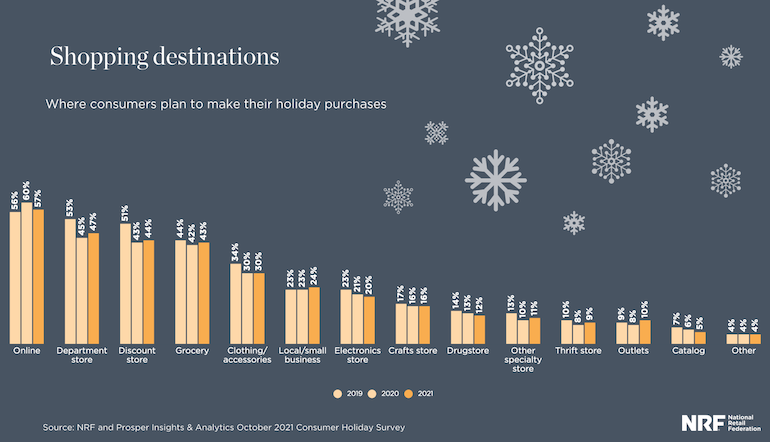
Supply shortfalls, higher prices loom
Weighing on the minds of many consumers are lingering supply shortages since the onset of the pandemic. Forty-seven percent of holiday shoppers in the NRF/Prosper survey said they’re worried about finding the products they want this season, led by electronics (44%), clothes (40%) and toys (28%).
NRF said it expects retailers to hire 500,000 to 665,000 seasonal workers for the 2021 winter holidays, up from 486,000 in 2020. Some hiring may have been pulled into October, as many retailers urged households to shop early to avoid out-of-stocks and shipping delays, NRF noted.
Other factors that could impact holiday sales include the potential emergence of a new COVID variant, although infections and hospitalization have continued to decline recently, and predictions for a La Niña pattern of cooler and wetter weather in the north and warmer and drier weather in the south, which in the past jas correlated with stronger retail sales, NRF said.
“Pandemic-related supply chain disruptions have caused shortages of merchandise and most of this year’s inflationary pressure,” Kleinhenz explained. “With the prospect of consumers seeking to shop early, inventories may be pulled down sooner and shortages may develop in the later weeks of the shopping season. However, if retailers can keep merchandise on the shelves and merchandise arrives before Christmas, it could be a stellar holiday sales season.”
Deloitte’s 2021 holiday retail poll shows three out of four consumers concerned about out-of-stocks and about seven in 10 expecting higher prices this season. Meanwhile, six in 10 retail executives express concerns about receiving their holiday orders in time, while just over half expect pricing to be higher.
Thirty-nine percent of shoppers reported plans to begin shopping earlier this year, to ensure timely delivery (cited by 49%) and avoid stockouts (cited by 47%). Almost half (48%) said they’re at least somewhat concerned about shipping delays this holiday season. Similarly, Deloitte’s survey found, 43% of retail executives expect their ordered holiday inventory to be delayed, and 64% are worried about receiving inventory in time for the holidays — despite 43% of retailers placing their holiday orders earlier than in 2019.
“Retailers will see strong growth this holiday season, even as supply chain issues, inflation and highly bifurcated spending continue to impact our industry. Consumers have adapted to life during the pandemic and, even though they are venturing out again, digital engagement shows no sign of slowing,” Deloitte’s Sides said. “Retailers who remain resilient by offering promotions early, appealing to in-store and online shoppers, and planning their inventories well in advance, are likely to experience not just a robust holiday season, but will be well-positioned for continued sales into the new year.”
For consumers, though, getting a good deal may be tougher this year due to the potential for elevated prices and fewer promotions, Deloitte added. Among shoppers who plan to spend less this holiday season, 50% named higher food prices. Of those who expect to spend more this year, 39% said the increased level stems from the generally higher cost of goods. More than a third of consumers (37%) said they’re looking to snare better deals earlier in the season and, in turn, 36% of retail executives expect earlier holiday promotions.
“Despite improving consumer sentiment and spending growth, the pandemic continues to influence how the holiday season will play out,” according to Stephen Rogers, executive director of the Deloitte Insights Consumer Industry Center. “Due to ongoing supply chain challenges, consumers will not only need to check their holiday lists twice, but early. We believe those retailers that embrace the next normal and meet these shifting consumer demands will experience holiday cheer in the coming months.”

